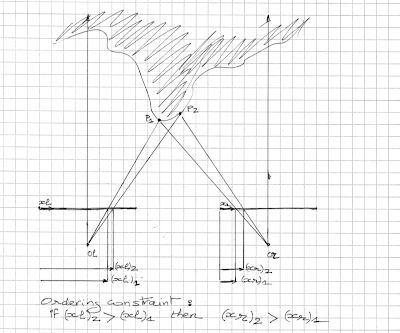This stereo pair is larger than what I have used before. I wanted here to have large images so that the disparity range would be large as well. The bigger the disparity range, the smoother the depth map is gonna look like (more shades of gray in the depth map). The min and max disparities are -62 and 0, respectively. The width of the images is about 1600 pixels. Of course, it takes much longer to get a depth map for a 1600 pixel wide stereo pair than a 800 pixel wide one but the results are much better, in general.

Dense depth map generated by DMAG3 using lambda=30 (smoothing parameter) and K=30 (occlusion penalty).
The "snow flakes" (isolated pixels that are much lighter than they should be) show up as "peaks" in the 3D rendered scene (see video below). There are many ways to get rid of them. One rather simple way is to open up Gimp or Photoshop and get rid of them one by one using, for instance, the fuzzy selection tool and the paint bucket tool. Of course, this kinda assumes you don't have too many of those.
I've used Gimpel3D to generate the wigglegram frames using an eye separation of 2 and 1. The frames were assembled in Gimp and saved as an animated gif. The whole process is a bit tedious, which is why the wigglegram carries only 5 frames.
Here's a video that shows the whole thing:







